8 Jaw-Dropping Natural Spectacles in North America
When you think of the natural wonders of the world, visions of the Great Barrier Reef, the Northern Lights, and Mount Everest probably come to mind. While these are amazing, there are lesser-known natural phenomena that deserve recognition, and some are right here in North America.
From enormous hot springs to glowing waves, here are eight truly jaw-dropping natural spectacles and natural wonders in the United States and beyond that are well worth a stop on your next summer adventure—if not a dedicated pilgrimage of their own.
1. SYNCHRONOUS FIREFLIES
Tennessee, United States
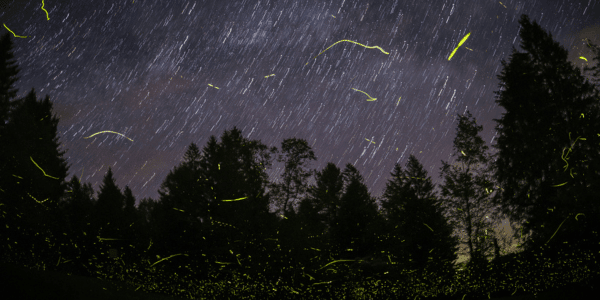
Deep in the forests of the Great Smoky Mountains National Park is a light show of synchronous fireflies unlike any you've ever seen. For two weeks in early summer, the over 19 species of fireflies in the park have matured into adult forms and are ready to begin mating. As part of their rituals, an innumerable amount of these enchanting insects synchronize their flashing patterns and light up the night.
No one knows why the fireflies collectively flash their lights, but the bioluminescent display is a stunning feat. An unexplained event, it's performed by just a few types of fireflies in North America and in a handful of places worldwide.
Synchronous Fireflies FAQs
Where can I see synchronous fireflies in 2024?
You can see the synchronous fireflies in Tennessee and North Carolina in the Great Smoky Mountains National Park.
When are the synchronous fireflies?
The best time to see synchronous fireflies is in late May or early June.
2. GRAND PRISMATIC SPRING
Wyoming, United States
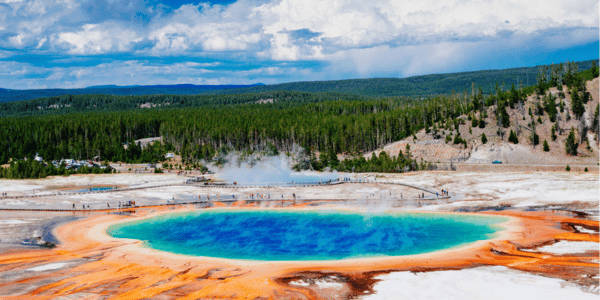
Old Faithful isn't the only natural beauty turning heads in Yellowstone National Park. At 370 feet in diameter—bigger than a football field—the Grand Prismatic Spring is the third-largest hot spring in the world. The steaming-hot water comes from a crack in the Earth over 121 feet below the surface and produces such extreme heat that almost nothing can sustain it.
It's more than huge and scientifically fascinating; it's incredible to see. Thanks to the thermophile (or heat-loving) bacteria in the water around the spring, the deep blue center is surrounded by technicolored bands of vivid green, orange, and yellow. Most vibrant between May and September, the rainbow marvel is one of the country's iconic wonders and nature's greatest gifts.
Grand Prismatic Spring FAQs
How hot is the Grand Prismatic Spring?
Grand Prismatic Spring temperatures range from 145°F to 189°F.
Where is the Grand Prismatic Spring?
The Grand Prismatic Spring is in Yellowstone National Park.
Why is the Grand Prismatic Spring so colorful?
The Grand Prismatic Spring is so colorful because of the thermophile bacteria.
3. THOR'S WELL
Oregon, United States

Off the coast of the Pacific Northwest in Yachats, Oregon, lies the "drainpipe of the Pacific," which appears to swallow the seawater around it into a bottomless pit. Named after Thor, the Norse god of thunder, this behemoth sinkhole isn't actually a well but a hole in a large rock that gives the illusion of draining the water around it. Researchers believe it started as a sea cave, and water eroded the bottom over time.
When seen in a storm or at high tide, the lashing waves flowing water into Thor's Well is an extraordinary spectacle. Right off Highway 101, it's a necessary stop on a summertime west coast road trip.
Thor's Well FAQs
How deep is Thor's Well?
Thor's Well is about 20 feet deep.
Where is Thor's Well?
Thor's Well is in Yachats, Oregon.
How to get to Thor's Well?
Thor's Well is right off Highway 101. You'll need to keep an eye out, as there are no signs for it. The best place to park is at the Cape Perpetua Visitor Center.
4. GRAVITY HILL
Pennsylvania, United States

We'd like to see Isaac Newton explain this one: an on-Earth landmark that defies gravity. It's true; in Pennsylvania, there are three gravity hills in New Paris, Lewisberry, or Wexford that refute the laws of physics. Here, cars, balls, and water roll uphill instead of down without assistance or hocus pocus.
If you put your car in neutral on these hills, you'll appear to be rolling upwards—but in reality, it's just an optical illusion caused by the angle of the road. A mysterious attraction rarely found by tourists, what happens at this secluded intersection will surely blow your mind.
Gravity Hill FAQs
How does Gravity Hill work?
While we wish it were real, gravity hills are just an optical illusion created by the angle of the road.
Where is Gravity Hill?
The best gravity hills are in New Paris, Pennsylvania; Lewisberry, Pennsylvania; and Wexford, Pennsylvania.
5. SPOTTED LAKE
British Columbia, Canada
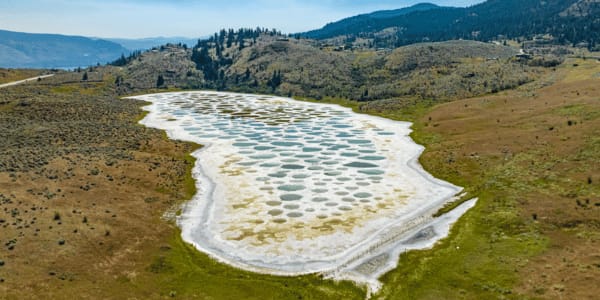
Located northwest of Osoyoos, British Columbia, Spotted Lake looks like any other in the fall, winter, and spring—but as the warm summer air sets in, the water evaporates, and hundreds of multicolored briny pools are uncovered.
The yellow, blue, and green polka-dotted landscape develops because of the high concentrations of minerals collecting in the water. The minerals seep down from hills surrounding the lake and pool together, forming various pods of different colors. Appropriately dubbed "the most magical place in Canada," the area has a sacred history and is culturally and ecologically sensitive; however, visitors are encouraged to view this intriguing and significant body of water from a distance.
Spotted Lake FAQs
Where is Spotted Lake located?
Spotted Lake is northwest of Osoyoos in British Columbia, Canada.
Why is Spotted Lake spotted?
Spotted Lake gets its spots from the highly concentrated minerals in the water that seep downhill and form colored pods.
6. BIOLUMINESCENT SHORE
California, United States
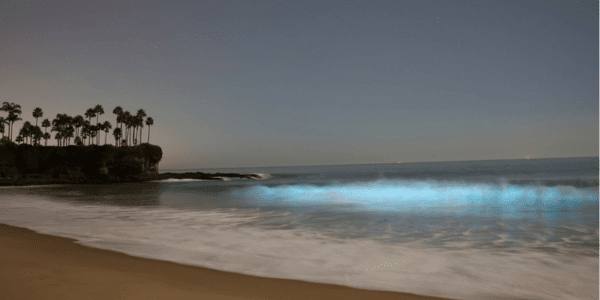
Did you know San Diego's famous beaches have glow-in-the-dark waves? During the spring and summer, bioluminescent algae collect in the warm waters off the Southern California coast, creating an awe-inspiring light scene in the evenings.
Though these algae aren't guaranteed at any San Diego beach, there are a few things you can do to optimize your chances of seeing them. First, choose a shore far from downtown and bright lights—these algae like darkness and lots of it. Second, check "red tide" monitors for an alert. The algae reproduce quickly when the water has the nutrients they enjoy, which makes the water turn a reddish color. If you're lucky enough to experience these unpredictable electric swells, it's a captivating and blissful treat.
Bioluminescent Shore FAQs
When are the bioluminescent waves in San Diego?
Bioluminescent waves are best seen in early spring and late summer.
Where is the bioluminescent beach in San Diego?
The Scripps Pier in La Jolla and Torrey Pines State Beach are ideal places to see the bioluminescent waves in San Diego.
7. MANHATTANHENGE
New York, United States
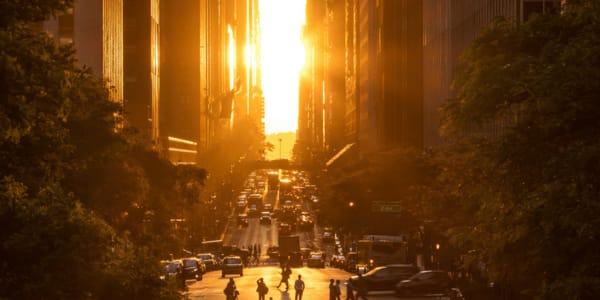
Nature isn't something most people associate with New York City. However, twice in the summer, an urban celestial event occurs, and the setting sun is perfectly framed within the east-west streets of the city's main street grid. The name of this phenomenon, Manhattanhenge, was coined by astrophysicist Neil deGrasse Tyson and is a nod to Stonehenge, the prehistoric monument that was constructed to align with the sun on the solstices.
This mesmerizing occasion results in a remarkable sunset that bathes the concrete jungle in a radiant glow. Typically taking place about three weeks before the summer solstice and again three weeks after, experts recommend heading to the Big Apple's major cross streets downtown, like 14th Street and Broadway, and facing west towards the sunset for the best views and photo-ops.
Manhattanhenge FAQs
When is Manhattanhenge 2024?
Manhattanhenge happened on July 12 and July 13 in 2024.
What is Manhattanhenge?
Manhattanhenge happens when the setting sun is framed within the east-west streets of the main street grid.
Where to see Manhattanhenge?
You can get a great photo of Manhattanhenge on major cross streets that run east to west.
8. TURTLE SPAWNING
Pacific Coast, Mexico

A true bucket list item for all ages is witnessing the hatching and pilgrimage of baby sea turtles across the beach and into the ocean. Luckily, this is a common sight on Mexico beaches during the summertime and a delightful reminder of how special nature is.
Mother sea turtles nest between June and August, and turtle hatching season generally runs from early May through late November. Since the sea turtle population in Mexico is protected, volunteers will release the hatchlings and supervise their journey across the beach and into the safety of the ocean waves. They'll look for food and navigate the open waters in groups before venturing out on their own to live for up to 50 years or more. The majestic rite of passage draws eager crowds and is an unforgettable encounter for spectators.
Turtle Spawning FAQs
When is turtle spawning season?
Turtle spawning season is between May and November in the Northern Hemisphere.
Beyond Natural Wonders in North America
Thor's Well, Spotted Lake, and the Grand Prismatic Spring are among the most iconic natural wonders in North America. Want to add more hot spots to your travel bucket list? Check out 7 of the happiest cities to visit in North America and get ready for a feel-good vacation!